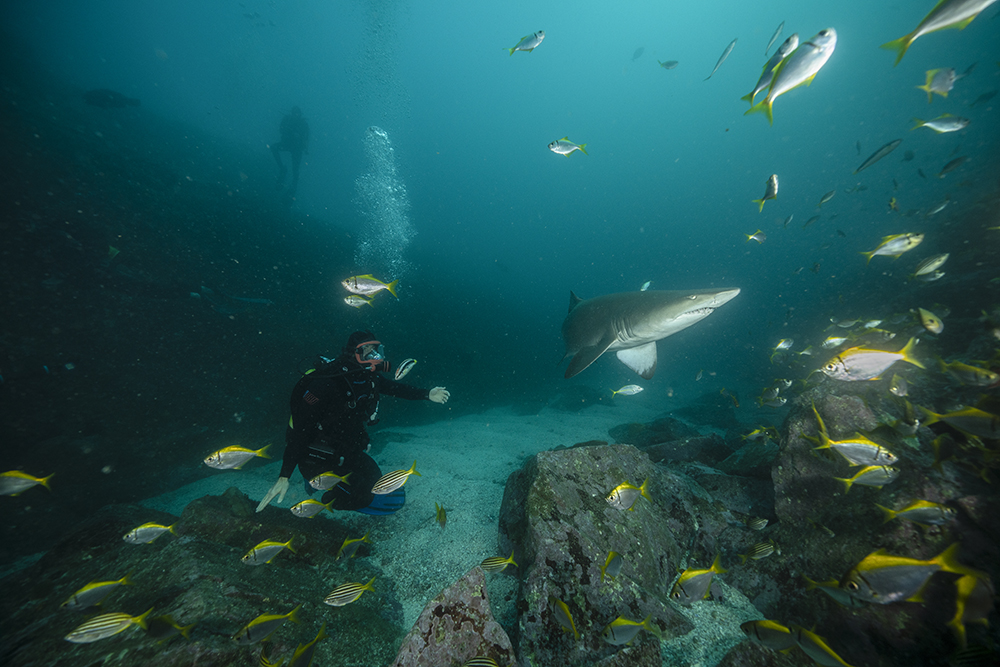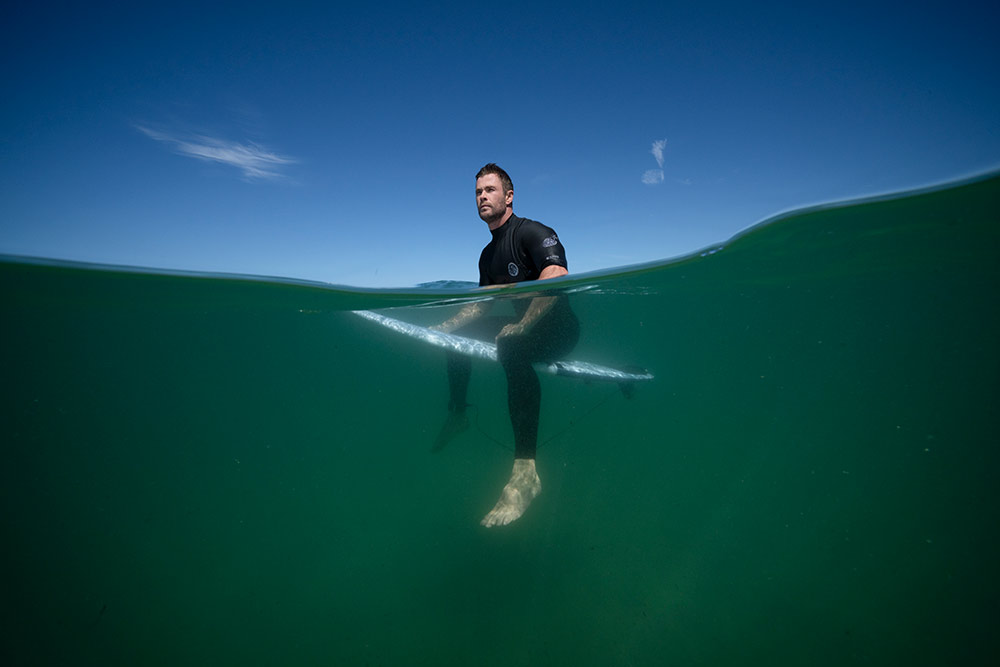A new special from National Geographic, sure to please all the shark lovers out there, will air Monday, July 5.
Shark Beach with Chris Hemsworth is a one-off special, actor Chris Hemsworth (Thor, The Avengers), embarks on a personal mission to investigate how we can live more harmoniously with sharks.
Hemsworth, an enthusiastic surfer, and renowned environmentalist is fascinated by the ocean’s top predator. But he’s equally perplexed by the dangers they pose to humans when we venture into shark territory.
He dives with sharks himself and accompanies a tagging team as they handle a captured great white, helping release it back into the ocean. Hemsworth’s mission to understand sharks is more than a journey: he’s searching for answers to help us live more peacefully with these magnificent creatures.

In Shark Beach, Chris uncovers the complicated truth behind the alarming increase in shark attacks in Australia. Joined by surfers, conservationists, shark advocates, and marine biologists, Chris begins his journey in his own backyard at Byron Bay, Australia. He explores new preventative measures and technology which can help stave off shark-human encounters.
One of those measures is the use of various shark bite deterrents. He brings on professor Charlie Huneveeers as an expert in the field of shark deterrents.

Professor Huveneers leads the Southern Shark Ecology Group within the Marine & Coastal Research Consortium at Flinders University. The Southern Shark Ecology Group delivers high-quality research on the biology, ecology, and population status of chondrichthyans, as well as assessments of their vulnerability to fishing pressure, interactions with humans, and related public perception.
Huneveers has over 15-year experience working on sharks and rays, and was one of the first to scientifically test the efficacy of personal shark deterrents. Over the last 10 years, Charlie has led multiple studies related to shark bite mitigation measures on a broad range of species (white sharks, bull sharks, and blacktip reef sharks) and across various locations around the world, including Australia, New Caledonia, South Africa, and French Polynesia.
Huveneers recently sat down with Innovation & Tech Today to discuss the show and what he feels is the hope for shark deterrents.
I&T Today: I was watching the show the other night and it’s an interesting piece of technology you guys are working with. What can you tell me about it?
Charlie Huveneers: Yeah, I guess I’ll have to say straight up, we’re not the manufacturers. We’re only the group that tested the equipment. So, obviously, I know of the technology, but maybe not any intricacies that you might be after, but we’ll see how we go. So, the whole idea is basically, it’s a strong electric pulse being transmitted between two electrodes. And the theory is that sharks can detect very weak electric fields. But obviously, there’s a lot that goes into an electric field. There can be many, many different types of electric fields you can use. Direct currents, alternative currents, or AC/DC. The voltage can be different. The frequency of the pulse can be different. The duration of the pulse can be different as well. And interestingly, what we found is that we tested different devices that had different fields, characteristics, and the efficacy of the devices was different as well. So whilst electric fields can deter sharks, not all types of fields were equally deterring the sharks in the same way.
I&T Today: Oh, wow. I wouldn’t have expected that.
CH: And we didn’t expect that. I actually did think that an electric field, as long as it’s strong enough, would have the same effect, but it wasn’t the case. The trick was that the two devices that we tested had very different characteristics. It wasn’t just one thing that was different. They were different in terms of their voltage, their frequency, duration, and even the type of current. One was an alternative, the other one was direct. So, which characteristic was the key factor making the deterrent work or not work? We’re not sure because there were so many differences between the two. But, yeah, it was interesting to see that not all electric fields are equal.
I&T Today: Was there is a difference then in how the shark reacts between direct or alternating current?

CH: For example. But again, we don’t know if the difference was because of the direct or alternative, or if the difference was because of the difference of voltage. Or was it because of the frequency of the difference, because every characteristic was different? We don’t know if it’s the combination of them that led to the discrepancies in behavioral responses, or whether it’s one specific one that led to the change.
I&T Today: And didn’t you say it was about 60% effective?
CH: Yeah. From our testing, that’s what we found. And we’ve also tested the same type of deterrent on bull sharks with colleagues from Reunion Island. And we also found a similar efficacy on the bull shark as well. It doesn’t mean that it’s going to be the same across all species, because different species have different sensitivity to electric fields. But so far with the bull sharks and tiger sharks, we found a similar percentage of the efficacy of about 60%.
I&T Today: Well, that’s a better chance than you have without it.
CH: That’s right. And again, I think it’s important for people to realize that it’s not foolproof, that you can still be bitten, but that based on our testing, it is reduced by 60%. The other thing to keep in mind is that with our testing, doing the science behind it, we have to get a lot of what we called replication or sample size. So, we keep having to do it over and over and over again, to be able to make strong statistical analyses. To be able to do that and get that many bites, or attempted bites, on the device, on the board, we ended up using bait as well as using a bit of burley. So, in a way, one could argue that it was a bit of an extreme situation when the sharks were actually quite motivated to come to take that bait. Even in that situation, we had a reduction of 60%. So, we’re obviously not sure, but one could think that in the case of a human when the motivation might be less than for a piece of tuna, the efficacy might be even greater.
I&T Today: That’s quite impressive. And I have a different kind of question for you though, related to this. Why sharks? What brought you to where you are today?
CH: So, my interest is mostly as a marine biologist, and it’s mostly from an ecological or biological perspective. I’ve been interested in sharks since I was about 12 years old. And I remember the first time I was reading a book about it, is how much… Well, half the book kept on saying how much we didn’t know about sharks and that kind of piqued my interest in wanting to learn more about it. And obviously help, yeah, people how to better understand sharks and better understand the ecology and biology. I guess one of the key issues with sharks is that not all species, but a lot of species are highly vulnerable from overfishing. And whilst sustainable fishing can happen with sharks, in a lot of cases, it isn’t sustainable. And there’s a lot of issues at the moment in terms of the conservation state of the sharks. And a lot of shark populations have been declining. Obviously, some countries are doing better than others. But yeah, a lot of my work is related to shark conservation because of the overall stages of a lot of these species. But again, that’s a bit of an overgeneralization. Whilst overall, sharks are in trouble, not all species have been declining.

I&T Today: Is there anything on the market now already, in the vein of what you guys are working with?
CH: So, yeah. All the product we’ve been testing are already commercially available. And that’s one of the things that, it’s a bit tricky and it’s a bit strange in a way, that there are no current regulations or rules about these products becoming available. And in a way, the kind of statements that manufacturers can make about this product. And that’s why we’ve been feeling very strongly about making sure that we are doing some scientific testing on this product as quickly as possible so that people don’t end up using one of these things, thinking that it works, and potentially putting themselves at greater risk than they normally would because they think that they’re safe because of this product. Which in reality, doesn’t do anything. Because there’s a lot of them that actually don’t do anything.
I&T Today: I bet there are. I’m envisioning a lot of copper bracelet kind of stuff that you used to see around.
CH: Yes. Very true. And it’s very easy to say that something works when there are… If people… Because the risk of a shark bite is so low, you can basically use anything and say, “Well, I haven’t been bitten today, so it worked. So I always go diving with my wooden spoon and I’ve never been bitten by a shark while carrying my wooden spoon. So, a wooden spoon is the best shark deterrent ever.”
I&T Today: Makes sense. It’s what happens when people play with logic.
CH: Yeah, exactly. And you can see how people might think that way, but it does lead to a lot of claims out there, and a lot of unsubstantiated claims. And that’s why, it sounds biased being a scientist, but the ability of science to provide the right information so that people can make the right decision is, I think, very important.

I&T Today: So, how long have you all been testing it? Is this something you’d just started on or was it a short-term test, or?
CH: First study on the efficacy of shark deterrents that we did was back, probably about 2011. So, we’ve been doing some testing for over the last 10 years. Obviously, how much testing we do goes up and down with the different products being released. But yeah, we’ve been doing it for a long time. And over the years, we’ve tested many different products on many different species. And we’re just about to start some more tests on some of these electric deterrents but on tiger sharks this time. And that’s because we can’t assume that, if it works on one species it would work on the others. So we want to make sure that what we’re seeing with white sharks is the same thing for tiger sharks as well.
I&T Today: So you guys have been working with various types of sharks along the way as well then?
CH: Yep. Yeah, so far we’ve tested on white sharks and bull sharks, and blacktip reef sharks. And we’ve also actually looked at whether this technology could be used in relation to fisheries to reduce the bycatch of some sharks and rare species. So for example, the sawfish is one of the most vulnerable species in the family of sharks. And they are still being caught as part of some of the trawl fisheries in Australia. And there’s a lot of work trying to reduce the bycatch of these sawfishes in the trawl fishery. We were looking at whether this type of electric field could be placed at the front of the trawler, at the front of the nets, to deter the sawfish as the nets were going through. So that’s another application. It’s not related to protecting humans, but in that case, it’s actually related to protecting the sharks or other rays.
I&T Today: I guess that’s something you have to balance as well. Is ensuring it’s enough to shake a shark off, but not so much that you’re harming it.
CH: Yeah, that’s right. And I guess, the idea is that either when the net is approaching the sawfish, for example, or when the shark is approaching the deterrent, they will start feeling it from slightly further away. So, if they’re deterred within a meter, it’s already going to start feeling it for maybe two or three meters. So, they’re not going to be approaching to the extent at which it’s going to harm them. Or in the same way, with a net approaching a sawfish, the sawfish will start… staying motionless on the seabed… will start feeling that net approach, or the deterrent, before it becomes too strong and will leave before it becomes harmful. So these deterrents are by no means meant to be harmful in the way of a collar or anything like that. It’s really considered a non-lethal, mitigation measure. In terms of trained behavior, some people are referring to it, but for an association to be made, you need a certain number of encounters with a device for any kind of learning to take place. And we don’t think that sharks would be likely to be exposed to the device in enough time, within a short period, for any kind of learning to take place. And that’s something that would be worth testing. It’s like, how much exposure is required for a shark to either learn that the area or that this device is really bad and never come back? Or the other way around. Can the sharks become habituated to that pulse and through time start being able to break the barrier in a way, and for your device to become less and less efficient?











